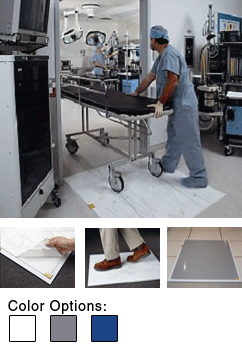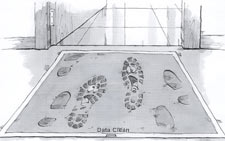Contamination Control Mats
Stop Dirt In Its Tracks With Contamination Control Mats
Everyday contamination can lead to dramatic equipment failure! And most of the contamination found in your controlled environment walks right in through the door. But, you can reduce your risk of contamination-related failures with Data Clean Contamination Control Mats.
 Each mat has multiple ultra-thin sheets of quality adhesive-coated film. Mats can be placed inside a low-profile, no-trip, non-skid frame attached to the floor. As foot
traffic or wheels pass over the mat surface, the non-transferring adhesive
locks onto dirt and holds it for disposal. When the exposed sheet becomes
soiled and non-tacky, simply peel it off to expose a fresh sheet.
Each mat has multiple ultra-thin sheets of quality adhesive-coated film. Mats can be placed inside a low-profile, no-trip, non-skid frame attached to the floor. As foot
traffic or wheels pass over the mat surface, the non-transferring adhesive
locks onto dirt and holds it for disposal. When the exposed sheet becomes
soiled and non-tacky, simply peel it off to expose a fresh sheet.
Contamination mats should be placed at each entrance to your controlled environment. Mats should also be placed adjacent to construction, remodeling, or other dust-causing maintenance activities. Whether inside or out, dust and contamination have a way of finding their way into your rooms.
Data Clean
Contamination Control Mats are your first line of defense against particulate
contamination.
Mats come in a variety of sizes and most with optional frames. Popular Sticky Mat sizes: 18"x36", 24"x30", 24"x36", 36"x45".
All Mats are Not Created Equal
- Anti-microbial agent - the acrylic adhesive does not support microbial growth
- Each sheet removes up to 95% of particles at .30 microns
- 1.4 Mil sheet thickness prevents tearing - 30% thicker than standard mats
- Quality manufacturing ensures mats are the perfect stickiness. Mats are produced in a controlled environment to help prevent gummy adhesive from sticking to shoes and being tracked into your clean room. Every case is tested and lot-coded.
- Numbered tabs indicate the number of remaining sheets left on your contamination control mat
- Contains GMO free, renewable, plant based Cardia Biohybrid™ material that reduces C02 emissions
- Recyclable
Choosing a Mat Size
To determine your size, observe the position of the door, type of door, size of door, and foot traffic pattern. Choose a size large enough that individuals will not be able to avoid the mat. For a 36" door, you might choose a 26"x45" mat, positioning the mat with the short edge against the door frame so that the 45" length captures a set of footprints. Choosing a Mat Color - Why White?
Choosing a Mat Color - Why White?
White sticky mats show dirt better. A white mat is more likely to be properly maintained than gray or blue because it's more apparent when a fresh layer is needed.
Gray and blue mats hide dirt better. Gray and blue are often chosen for aesthetic reasons.
Frame or No Frame?
Order sticky mat refills with or without a reusable, repositionable frame. Mat frames are optional. Besides providing an improved aesthetic appearance, mat frames are recommended for rough or carpeted floor surfaces and for locations where the mat may need to be temporarily relocated for maintenance or other activities. A frame prevents a mat from shifting when the surface is uneven or dirty.
Most persons prefer to use a frame.
If your environment allows water, mopping around the mat can cause the edges to curl. With a frame, mats can be removed before cleaning. Frames can also prevent the accumulation of adhesive until mats no longer stick.
If you are new to frames, try a Data Clean's Intro Mat Kit: 25"x31", 31"x50". Introductory Mat Kits include a starter mat and reusable frame.
Positioning Your Mat
Always place numbered tabs closest to your clean area so that sheets are removed in the direction away from the clean room. Place mats outside the room at every entrance with the numbered tab closest to the clean area so that when a sheet is removed, the contaminated sheet is peeled away from the entryway. When mats are positioned inside the environment at each exit, position the numbered tab nearest the room interior so that when a sheet is removed, the contaminated sheet is peeled toward the exit.The length of the mat should capture a set of footprints, a minimum of 30". Install smaller mats so that the longer side of the mat follows foot traffic: 18"x36", 18"x45", 24"x30".
Installing Your Mat
Make sure the floor surface (or frame, if using a frame) is completely dry and free of debris. Use a damp wiper to remove any latent dust. The bottom of the mat has a sticky sheet protected by a clear cover sheet. Remove this cover sheet to expose the bottom "sticky" sheet. Then, place the mat in the desired location. If you are using a frame, center the mat on the frame surface. When you are ready to use your mat, remove the clear cover sheet on the top to expose the first sheet.
Hint: The sheet numbers face up after installation.
Hint: If your mat was placed on a dirty surface or no longer remains stuck to the floor or the frame, you can use double sided carpet tape (not the thick foam type) to anchor it again. The tape is available at most hardware and home stores. Turn your mat over, brush off any debris and place 3 or 4 strips of carpet tape across the bottom of the mat. Again, make sure the floor or frame surface is completely clean and dry before adhering the mat.
 Properly Removing Each Sheet
Properly Removing Each Sheet
Use the numbered tab to initiate the sheet removal, then slowly peel up the edges toward the middle to form a bag. Always peel sheets in the direction away from your critical environment.
By forming a bag with the sheet during removal, you prevent trapped contamination from becoming airborne.
Expose a fresh layer before a sheet loses all its stickiness. If you wait until it is no longer sticky, you've waited too long.
Re-ordering Mat Refills
This will depend upon the contaminates in the environment, the amount of foot traffic, and how long it takes you to process supply acquisitions in your company. Typically reorder mats when you are a few weeks from running out.
